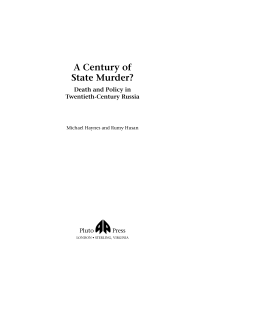
Additional Information
Book Details
Abstract
Russia has one of the lowest rates of adult life expectancy in the world. Average life expectancy for a man in America is 74; in Russia, it is just 59. Birth rates and population levels have also plummeted. These excess levels of mortality affect all countries that formed the former Soviet bloc. Running into many millions, they raise comparisons with the earlier period of forced transition under Stalin.
This book seeks to put the recent history of the transition into a longer term perspective by identifying, explaining and comparing the pattern of change in Russia in the last century. It offers a sharp challenge to the conventional wisdom and benign interpretations offered in the west of what has happened since 1991.
Mike Haynes and Rumy Husan have produced the first and most complete and accurate account of Russian demographic crisis from the Revolution to the present.
'A vivid and chilling account of some of the most terrible events of modern history'
Noam Chomsky
'Vividly portrays the casual brutality characteristic of central rule from Moscow'
Peace News
Table of Contents
| Section Title | Page | Action | Price |
|---|---|---|---|
| Contents | vi | ||
| 1 Demography the Social Mirror? ? | 1 | ||
| Lies, damned lies and statistics? | 4 | ||
| Murder most foul? | 9 | ||
| A century of population change in Russia | 13 | ||
| The mirror of society? | 17 | ||
| 2 The Revolt Against Class Society 1890 1928 | 26 | ||
| Mortality in Tsarist Russia | 28 | ||
| The class pattern of death | 34 | ||
| War and repression | 40 | ||
| Revolution and the vision of the future | 45 | ||
| The waning dream | 57 | ||
| 3 Stalin, Mass Repression and Death 1929 53 | 62 | ||
| The pressure of accumulation | 62 | ||
| The total number | 63 | ||
| Death and repression | 66 | ||
| The determinants of the normal death rate | 73 | ||
| Wars | 77 | ||
| The end of the Stalin era | 84 | ||
| 4 Policy, Inequalities and Death in the USSR 1953 85 | 90 | ||
| Judicial death and repression | 91 | ||
| Imperialism and war | 94 | ||
| The pattern of normal death | 98 | ||
| Explaining the patterns of death | 105 | ||
| National variations within the USSR | 115 | ||
| 5 The End of Perestroika and the Transition Crisis of the 1990s | 119 | ||
| Perestroika and the collapse of the USSR 1985 91 | 119 | ||
| Shock therapy reforms of 1992 | 125 | ||
| The impact of reforms: low pay, poverty and inequality | 134 | ||
| Mistaken assumptions underlying the reform programme | 139 | ||
| 6 Normal Deaths During the First Decade of Transition | 144 | ||
| Unprecedented peacetime mortality | 145 | ||
| Why so many deaths? | 150 | ||
| Key factors of mortality decline | 156 | ||
| 7 Yeltsin, Putin and Abnormal Deaths 1992 2002 | 176 | ||
| Collective violence and intentional deaths | 176 | ||
| Political crisis and civil unrest | 179 | ||
| Death and disease in prisons | 181 | ||
| Torture and state executions | 187 | ||
| The war in Chechnya | 191 | ||
| 8 Conclusion | 202 | ||
| Class, inequality, and a quiet violence | 202 | ||
| A century of state murder? | 206 | ||
| Appendix: Basic Data on the Prison Camp System under Stalin | 214 | ||
| Notes | 216 | ||
| Bibliography | 240 | ||
| Index | 255 | ||
| Abramkin, Valery | 181 |
